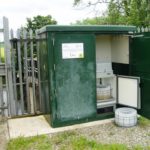Source to Tap are monitoring water quality in the River…
Blue Dot Catchments – working to let life thrive in some of our wildest waters
Cormac McConigley from the Local Authority Waters Programme tells us about work on the Blue Dots programme. This programme is trying to prevent any further decline and restore high status waters around Ireland and recently brought together people to work on a vision and plan for how to do this…
The River Basin Management Plan 2018-2021 sets out the targets and measures Ireland will implement to achieve the objectives of the Water Framework Directive. One of the key measures to address the decline in high status water bodies was the setting up of the Blue Dot Catchments Programme to specifically target the maintenance and restoration of high status objective water bodies. The programme is directed by a Blue Dot National Steering Group which had its inaugural meeting in January 2019 and adopted a work programme in September 2019.
High status water bodies are our waters with the highest quality nationally. The Water Framework Directive classifies water bodies into one of five classes – High, Good, Moderate, Poor and Bad status. To achieve High ecological status, a water body largely reflects undisturbed conditions with only minor pressures and are often used as a benchmark for where our water quality should be.

These waters often support biodiversity which has been lost or has suffered significant declines elsewhere in our landscape and therefore they are important for many our species such as e.g. salmon, the freshwater pearl mussel, slender naiad. In October 2019, an overview of the Blue Dot Catchments Programme was presented in the Catchments Newsletter. It was highlighted that Ireland has suffered a significant decline in our pristine or high status water bodies. High status sites have declined from 31.5% (1987-1990) to 17.6% (2013-2015) an almost 50% loss (Fanning et al., 2017). The most recent assessment of our river waters bodies from 2016-2018 has indicated that the decline has continued and is now at 17.2% of all sites. In particular the loss of our highest quality river sites which are identified as Q5 sites by the Environmental Protection Agency, have reduced from 13.5% (or approx. 500 sites) of all sites in 1987-1990 to only 0.7% (or 20 sites) in 2016-2018.
The overarching aim of the Blue Dot Catchments Programme is to protect or improve Irelands highest quality waters. To achieve this the programme requires the cooperation of local and public authorities, communities living and working with blue dot catchments, and all those who support them such as Catchment Groups, River Trusts, Tidy towns and others. This is particularly important to inform the development of a communications and engagement plan that can be used to engage with the communities that live in the catchments of Blue Dot waters.

The first step in preparing to engage with communities was to hold a Visioning Workshop where national stakeholders could come together and discuss a vision and branding for the programme and begin putting a framework for a communication and engagement strategy together. The workshop was held on 5th March 2020 in Tullamore and was attended by over 40 participants representing 22 organisations. A selection of organisations with expertise in water quality protection including local and public authorities, environmental NGOs, community group representatives and academics with research backgrounds on high status water bodies were invited to attend. Several introductory presentations were provided to set the scene. Attendees were then divided into 6 working groups via a pre-prepared selection process which ensured that a mix of organisations, NGOs, catchment groups, academics and LAWPRO staff were at each table. The discussion at each table was facilitated by a LAWPRO Community Water Officer (CWO). A flipchart was provided to each table so that thoughts, ideas, drawings etc could be documented, while notes on discussions were also taken by LAWPRO staff. The flipchart work and notes were collated at the end of the workshop and used to prepare this workshop outcomes report. Each table was asked to discuss and present ideas for the following four items:
- A vision statement for Ireland’s Blue Dot Catchments Programme
- Branding for Blue Dot waters
- How the Blue Dot Catchments Programme might best communicate and engage with communities that live in areas with Blue Dot waters
- Review the Blue Dot Catchments Programme 11 objective
Under each topic discussed, the ideas gathered will be used to further inform the Programme in the coming months.
A Vision
The workshop participants identified that the vision for the programme and Blue Dot waters would need to encourage people to view Blue Dot waters as valuable resources that should be cherished. The presence of a Blue Dot Water should be a source of pride to the communities that live in the catchment. It should be recognised that it is the practices of people in those communities that have allowed Blue Dots to persist where they have. These waters are unique habitats with special biodiversity, sitting within landscapes which offer multiple other positive benefits that should be highlighted and valued.
Many potential vision statements were drafted at the workshop. Across all the statements produced the most commonly used words were extracted to form the word cloud in Figure 2. This represents the main themes that the final vision will aim to incorporate. The most commonly identified terms were Protect, Restore, Community, Health, Climate, Integrated and Value. These words will form the basis of the final vision statement.

Developing an identity for the programme
The majority of workshop attendees agreed that the programme would need to develop a logo and accompanying strap line. Many ideas for both were put forward on the day as well as ideas on what a logo would need to represent. Several participants drew potential logos that could be used by the programme or form the basis for a logo to be designed by the steering group or others. Some common themes were for the logo to be blue, whether in the shape of a flowing river, as a dot, as the letter Q for quality, or a water drop. It was noted that there would be value in the logo being similar to the LAWPRO logo with its catchments theme. It was also broadly agreed that the logo would need to have some origin story behind it which communities could engage with. Work is progressing on finalising the visions statement and logo, after which a formal launch will take place.
Engaging Communities
As highlighted above, engaging communities is essential to the success of the programme. Workshop participants drew on their experiences to identify what has worked in the past and what has been less successful. In particular, the experience of the Community Water Officers working in the Local Authority Waters Programme is an invaluable resource for the programme to draw from. LAWPRO’s work with communities means they have gained significant understanding in recent years of what communities would like or need, and what supports they may also require.
The participants identified that the key to successful engagement is to begin early and to “press the flesh”. Successful engagement of this type must include workshops held in the community where thoughts and ideas can be gathered at the start. It is important that communities are asked what they want. How do they currently feel about their local waters? Do they know that they have a Blue Dot waterbody in the area? How valuable is this knowledge to the community? What actions are seen as possible to protect this valuable resource they have?
It was also highlighted that communities need a way to feed back into the programme about their local waters. They should be co-designers of any management that is to take place and be fully aware of what is happening. Public engagement around water bodies has improved over the years with LAWPRO leading the way to greater community involvement around water quality. The Blue Dot Catchments Programme will aim to build on this and foster greater community involvement for the protection of our most valuable waters.
Next Steps
The visioning workshop provided potential vision statements, logos, straplines and ideas about what the brand would need to represent. These outputs will now be used by a specialist to develop a brand for the programme and to inform a bespoke communications and engagement plan for Blue Dot waters.
An objective of the programme is to establish pilot projects for community engagement and action. This objective is also outlined in the River Basin Management Plan and the South-West was identified as the region where engagement should be piloted. The initial programme proposed the development of a three-strand “education, signage and action” pilot programme in conjunction with the South West Water and Environment Committee Chair to commence bottom up engagement with communities in Blue Dot areas and to provide an opportunity for learning what actions may be effective in other parts of the country. The Blue Dot Steering Group will develop ideas and proposals for the pilot in the coming months, and it will be informed by the proposed engagement plan.







